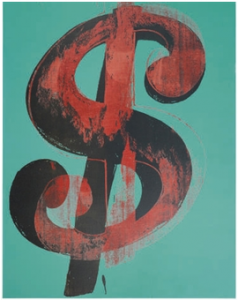Cheapsters in History
 When we think of Warhol, we initially think about his bold and simplistic silkscreen of a Campbell’s tomato soup can. In fact, google “Warhol” and the first image to appear is not a picture of Andy, but a picture of his classic 1964 “Campbell’s Soup Can” piece.
When we think of Warhol, we initially think about his bold and simplistic silkscreen of a Campbell’s tomato soup can. In fact, google “Warhol” and the first image to appear is not a picture of Andy, but a picture of his classic 1964 “Campbell’s Soup Can” piece.
Back in the mid-20th century and to a lesser extent today, Campbell’s tomato soup has represented a delicious, all-American, and economical meal. Paired with a piece bread, it is something that many Americans turn to for comfort when pockets are light.
Perhaps it is fitting that the most highly associated work of art by Andy Warhol is of an accessible, low-cost, factory-made item. Warhol’s roots lie in the blue collar, industrial city of Pittsburgh, where Warhol’s father worked in a coal mine. His childhood pauperism seemed to have influenced perhaps him not only in his work, but also in his lifestyle. In his book, “The Philosophy of Andy Warhol: From A to B and Back Again,” Warhol discusses his perspectives on money. Although some of his retellings seem to suggest he was at times a superfluous spender, overall Warhol conveys the message that he valued purchasing a lot of things for very little. That is, Warhol appreciated money for its color. He didn’t trust “anything but green bills” and what it could buy:
 “You take three people to a restaurant and you pay three hundred dollars…Then you take those same three people to a corner shop…and get everything there. You got just as filled at the corner shop as at the grand restaurant–more, actually— and it cost you only 15 or 20 dollars, and you had basically the same food.” Warhol felt satisfied in the idea of filling up on as little as possible and hinted at the absurdity of spendthrifts. Warhol also seemed to be very frank about the dollar bill, saying “Money is money. It doesn’t matter if I’ve worked hard or easy for it. I spend it the same,” which brings up the point that when money is gone, it is gone: A lesson in Sunk Cost. That being said, Warhol also expressed a useful social philosophy on money, perhaps based on an observation that “money is suspicious, because people think you’re not supposed to have it, even if you do have it.” His answer to this problem came from his poignantly said speculation: “I guess that’s all it is. Think rich. Look poor.”
“You take three people to a restaurant and you pay three hundred dollars…Then you take those same three people to a corner shop…and get everything there. You got just as filled at the corner shop as at the grand restaurant–more, actually— and it cost you only 15 or 20 dollars, and you had basically the same food.” Warhol felt satisfied in the idea of filling up on as little as possible and hinted at the absurdity of spendthrifts. Warhol also seemed to be very frank about the dollar bill, saying “Money is money. It doesn’t matter if I’ve worked hard or easy for it. I spend it the same,” which brings up the point that when money is gone, it is gone: A lesson in Sunk Cost. That being said, Warhol also expressed a useful social philosophy on money, perhaps based on an observation that “money is suspicious, because people think you’re not supposed to have it, even if you do have it.” His answer to this problem came from his poignantly said speculation: “I guess that’s all it is. Think rich. Look poor.”
In the end Warhol may have been at times a bit schizophrenic about his perspectives on money, but the underlying message is one of utility: Use it for what it is, not what it represents.




